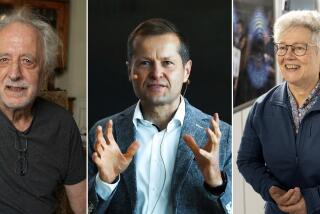UCLA Scientists Finding New Way to Split Atoms : Physics: Successful test promises smaller machines to do the job of huge, costly super colliders.
- Share via
Researchers at UCLA have taken a promising step toward a new generation of the high-energy machines that physicists use to pick the locks of creation.
With a pair of carbon dioxide lasers, they persuaded electrons to “surf” on plasma waves of superheated, energized gas, briefly speeding them up to the highest energy level seen so far. The technique accelerates particles more rapidly than modern atom smashers, like a car that can go from 0 to 50 m.p.h. in 100 milliseconds.
The work was reported by physicist Chan Joshi, a practitioner of what Discover magazine once called “long-shot physics,” and a team from UCLA’s electrical engineering department.
The results, published in Thursday’s edition of the journal Nature, “surpass all expectations,” the publication said.
“The physics is no longer a long shot,” Joshi said Wednesday. “This is telling us that a new way of accelerating particles works. But in terms of the technology, it still is a long shot. Whether it can be made into a working accelerator remains to be seen.”
Joshi’s experiment is part of a new wave of physics research that promises smaller, cheaper “beam machines” to study the fundamental structure of matter and the origin of the universe.
Such machines are designed to generate a subatomic fury of forces that can rip the fabric of matter and focus it on a point no more than a micron across. Today, particle physics is a world dominated by multibillion-dollar mega-machines that sprawl for miles.
Joshi’s findings were welcome news for many physicists who are still bitter over congressional cancellation of the controversial $11-billion superconducting super collider project in Texas.
“I am impressed,” said physicist James Simpson, who is working on accelerator design at Argonne National Laboratory outside Chicago. “I would consider this . . . the first proof of principle of this technique.”
Ronald Ruth, head of accelerator theory and special projects at the Stanford Linear Accelerator Center, called it “an important step forward.”
“This really proves out the idea,” he said.
The earliest particle accelerators--in which scientists first smashed the atom and examined the wreckage--were barely bigger than a breadbox.
Today, as scientists close in on the secrets of creation--the machines are big enough to encompass medium-size cities. The superconducting super collider, the most ambitious and largest experimental physics project in history, would have required an underground accelerator ring 54 miles in circumference.
In their efforts to explore the physical limits of the universe, physicists have run up against what appear to be insurmountable financial barriers, experts said.
If subsequent experiments at UCLA and other laboratories around the country are successful, scientists say, researchers one day may be able to whip nuclear particles up to speed in the length of a football field or less. But experts said Wednesday that Joshi’s work was only one of several basic approaches researchers are exploring and that all of them may take decades to perfect.






